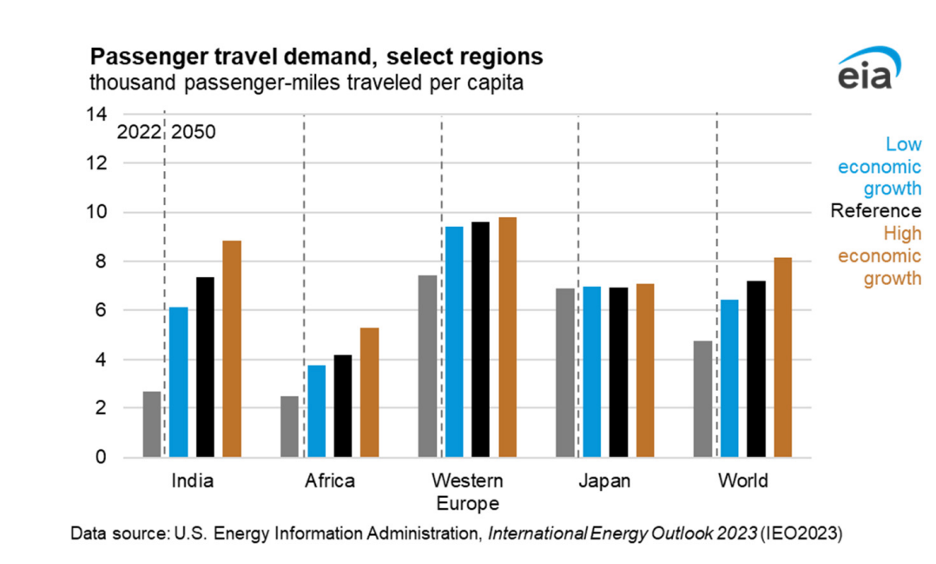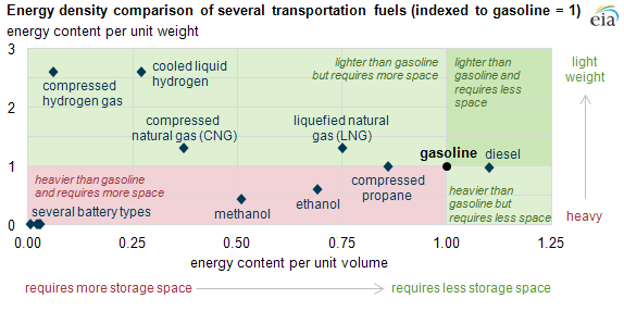The Case for E-fuels Use in Aviation

By Pete Rocha, LEC Partners
Special to The Digest
The aviation industry produces 2-3% of all CO2 emissions globally. This percentage will likely grow over time as the developing world becomes richer and the demand for air transportation increases. In the graphic below, we see that in passenger travel demand is expected to increase by up to 71% by 2050. This will undoubtedly result in a significant increase in the demand for aviation fuels, over the same time period when many countries are trying to achieve carbon neutrality.

What Are E-fuels & How Can They Help Decarbonize Air Travel?
E-fuels (short for electrofuels, also sometimes called synthetic fuels) are drop-in hydrocarbon replacements for fossil fuels. They are created by reacting hydrogen and carbon dioxide via the Fischer-Tropsch process to create molecules that are virtually identical to petroleum fuels like diesel and jet fuel. When made from green hydrogen, these fuels can be carbon neutral, i.e., they produce an equivalent amount of carbon in combustion as they are removed from the atmosphere when produced. Therefore, these e-fuels can drastically reduce carbon emissions from industries that rely on combustion engines.
Why are E-fuels Needed at All – Can’t We Electrify?
Battery electric vehicles will eventually replace most internal combustion engines in passenger transport. However, in applications where higher power density is required, like long-distance air travel, batteries do not provide enough power per unit weight to make transportation feasible. As seen in the graphic below, batteries have a poor combination of being heavy and having low energy content per unit of volume. Current lithium-ion batteries would need to double their energy densities just to be able to power regional flights.[1]Other battery technologies are under development, but it’s safe to say that long-distance flights will not be directly electrified anytime soon.

Source: U.S. Energy Information Administration, based on the National Defense University.
How do E-fuels Compare to Other Options?
E-fuels have some distinct advantages over other low-carbon fuels, including scalability and logistics. Sustainable Aviation Fuels (SAF) made from fats, oils, and greases (FOG) are already produced commercially today and can reduce carbon emissions by up to 80% depending on the feedstock. However, there is nowhere near enough waste, or even crop, oils grown globally to replace petroleum jet fuel. In the US alone, the demand for jet fuel in 2022 was approximately 23 billion gallons. The total oil feedstock for fuels was approximately 2.5 billion gallons – which after conversion to jet fuel, is less than 10% of the aviation demand. Also, much of the FOG supply is converted to on-road transportation fuels like biodiesel and renewable diesel, which traditionally have higher regulatory incentives than SAF. Since waste FOG, by definition, is the byproduct of other industries, it is difficult to scale up for fuel conversion. Only a globally massive planting of virgin crop oils like soy and canola can meaningfully contribute to oil production. The unintended consequences of planting more oil crops would be massive: land change, destruction of ecosystems, and likely deforestation in the developing world.
Another possibility is a fuel cell electric engine that uses hydrogen and oxygen to produce electricity. In addition to being potentially zero carbon, fuel cell systems also do not require combustion, so there are no harmful criteria pollutants, like nitrogen oxide and sulfur dioxide, produced. However, hydrogen is gaseous at room temperature and requires cooling, high-pressure compression, and special handling to ship long distances. None of those activities fit within existing fueling infrastructure and handling practices. Therefore, hydrogen transportation is currently expensive and limits widespread adoption as an end-use fuel. By contrast, e-fuels are chemical hydrocarbons, that are analogous to petroleum-derived fuels. They can use existing fuels infrastructure which eliminates the need to invest in new storage and distribution, removing a potential barrier to adoption.
Do E-fuels Require a Technical Breakthrough?
No, making e-fuels involves three technologically proven processes. First, green hydrogen is produced via electrolysis (splitting water), which was first discovered in 1789. The original discovery laid the groundwork for Alkaline Water Electrolysis which has been a commercial technology since the early 1900s. The most common electrolyzer type in use today is the Proton Exchange Membrane (PEM) electrolyzer, which was invented by General Electric in the 1960s. Today, major global manufacturing companies such as Cummins, NEL Hydrogen, and Siemens produce electrolyzers. While proven on a commercial scale, green hydrogen has historically not been able to compete economically with fossil-based hydrogen, limiting its deployment.
Carbon capture is required to produce CO2 from industrial streams. Post-combustion carbon capture from flue gas at industrial sites is a commercially deployed technology today. Industrial CO2 is made today by capturing the off gasses of industries like ammonia and alcohols and purifying them. The term Carbon Capture Utilization and Storage (CCUS) as it is generally used means capturing CO2 that is otherwise released in the atmosphere via industry today and using it in different industrial processes or storing it underground. However, the capture technology is the same as that which is already in commercial use. Slightly different is Direct Air Capture (DAC) which seeks to remove CO2 from the atmosphere, and not specifically from industrial sites. DAC today is considered a developing technology.
The Fischer-Tropsch (F-T) process for synthesizing hydrocarbons was invented nearly a century ago. Most notably F-T was used in Germany to create liquid fuels from coal, as Germany has limited petroleum reserves. Later, apartheid-era South Africa deployed F-T technology at its largest scale to produce liquid fuels when faced with energy embargoes. Sasol operates the largest South African plant with a capacity of 165,000 barrels per day, which places its capacity on par with most oil refineries.
What do E-fuels Cost Today: Are They Commercially Available?
The International Energy Administration (IEA) estimates the cost of synthetic hydrocarbon fuels between $114-367 USD/barrel.[2] This is significantly higher than the $48-95 USD/barrel for fossil fuels. Given current pricing, there is no large-scale production of e-fuels currently. However, several companies have already made project announcements for the first generation of e-fuels plants, including Saudi Aramco and the San Francisco Bay Area startup Twelve.
What is the Outlook for E-fuels in the Future?
The prospects for e-fuels are quite auspicious given current industry trends. Hydrogen from electrolysis has traditionally been far more expensive than its fossil counterpart, and therefore not suitable for commodity use. However, recent investments in electrolysis technologies and industry scale-up have lowered production costs. The price of green hydrogen is currently ~$5-7 USD per kilogram but is forecasted to reach costs of $1.3-3.5 USD/kg by 2030.[3] Similarly, the estimated cost to capture one MT of post-combustion CO2 is currently $40 USD, but $20/MT in the next decade is likely. With the raw materials for synthetic fuels expected to halve in a short time, the promise for price-competitive e-fuels is strong. CO2 from direct air capture is presently at least an order of magnitude more expensive.
Adding to the optimism for e-fuels is the promise of a strong regulatory environment that provides incentives for synthetic fuel producers. As an example, in the United States, the Inflation Reduction Act of 2022 creates incentives for CO2 capture and utilization and green hydrogen production through the 45Q and 45V credits, respectively. Additional premiums for low-carbon SAF are also present at the Federal level and in some states. The table below illustrates the highly lucrative credits for aviation e-fuels from CCUS and green hydrogen that can total up to $8.26/gal.
| Comparison of Potential Incentives under Select U.S. Programs | |||||
|
Potential Carbon Reduction
|
40B SAF Tax Credit/Gal
|
CA LCFS Credit/Gal@ $80/Ton CO2
|
IRA Incentives (45Q + 45V)
|
Potential Total Incentives/Gal |
|
| Hydrotreated Esters and Fatty Acids (HEFA)
|
26%-82%*
|
$1.25- $1.55
|
$.25 – $.675
|
None |
$2.23 |
| Synthetic Kerosene (aka e-JetFuel)
|
90%-108%✦ |
$1.75
|
$.72- $.90
|
$5.79 |
$8.26 |
* based on published HEFA pathways under the California Air Resource Board (https://ww2.arb.ca.gov/resources/documents/lcfs-pathway-certified-carbon-intensities)
✦ “Lifecycle Analysis of Electrofuels” (https://www.osti.gov/servlets/purl/1807679)
The credits under the IRA are not permanent and will sunset unless prolonged by new legislation. However, the point of this legislation was to expand carbon sequestration and low-carbon hydrogen production opportunities for investors and developers. Incentives generally lead to investment, which increases scale, innovation, and learning by doing. The cumulative effect of these trends is to lower the product cost over time.

The Verdict on E-fuels
Unless the mix of aviation fuels is changed, the aviation industry will be a large and growing emitter of CO2 for some time. Fortunately, e-fuels synthesized from captured CO2 and low-carbon hydrogen may offer an alternative to petroleum incumbents. Unlike renewable jet fuel from vegetable oils and waste greases, e-fuels are practically infinitely scalable. And contrasted to future fuels like hydrogen, e-fuels can use the same hydrocarbon infrastructure available today. With the confluence of declining prices from technological innovation and strong regulatory support, e-fuels could be poised to play a significant role in decarbonizing the aviation industry within the next decade.
About the Author
Pete Rocha has over 25 years of experience in thermo-chemical conversion technologies and serves as an expert at Lee Enterprises Consulting, overseeing matters involving hydrogen, biofuels, fuel cells, sustainable foods, food ingredients, and algae.
About Lee Enterprises Consulting
Lee Enterprises Consulting has over 180 experts that can help navigate your bioeconomy needs. If you need assistance with your bioenergy project(s), please Contact Us.
[1] https://www.technologyreview.com/2022/08/17/1058013/electric-planes-taking-off-challenges/
[2] https://www.iea.org/data-and-statistics/charts/simplified-levelised-cost-of-competing-low-carbon-technologies-in-long-distance-transport
[3] https://www.iea.org/reports/global-hydrogen-review-2021/executive-summary
Category: Thought Leadership, Top Stories














